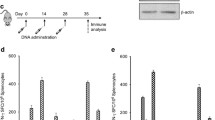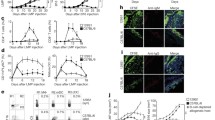Abstract
The major barrier for xenotransplantation in humans is the presence of α(1–3) Galactosyl epitopes (αGal) in xenogeneic tissue and the vast quantities of natural antibodies (Ab) produced by humans against this epitope. The binding of anti-αGal Ab to cells expressing αGal triggers a complement-mediated hyperacute rejection of target cells. The hyperacute rejection of whole cancer cells, modified to express αGal epitopes, could be exploited as a new cancer vaccine to treat human cancers. We tested this hypothesis in αGalactosyltransferase knockout (αGT KO) mice which, like humans, do not express αGal on their cell surfaces and can produce anti-αGal Ab. Forty-five percent of mice with preexisting anti-αGal Ab rejected αGal positive melanoma cells (B16αGal). These mice remained tumor-free for more than 90 days. The majority of control mice injected with B16Null, αGal negative cells succumbed to melanoma. The rejection of B16αGal induced strong long-lasting antitumor immunity against B16Null measured by the expansion of cytotoxic T lymphocytes. In addition, mice rejecting B16αGal were protected against melanoma since they survived a second rechallenge with B16Null. Protected mice developed antitumor immunity in the absence of autoimmune depigmentation (vitiligo). These results show that rejection of αGal positive melanoma cells can efficiently boost the immune response to other tumor associated antigens present in αGal negative melanoma cells. This study supports the concept of a novel anticancer vaccine to treat human malignancies.







Similar content being viewed by others
References
Baumann BC, Forte P, Hawley RJ, Rieben R, Schneider MK, Seebach JD (2004) Lack of galactose-alpha-1,3-galactose expression on porcine endothelial cells prevents complement-induced lysis but not direct xenogeneic NK cytotoxicity. J Immunol 172:6460–6467
Cui Z, Willingham MC (2004) The effect of aging on cellular immunity against cancer in SR/CR mice. Cancer Immunol Immunother 53:473–478
Cui Z, Willingham MC et al (2003) Spontaneous regression of advanced cancer: identification of a unique genetically determined, age-dependent trait in mice. Proc Natl Acad Sci USA 100:6682–6687
Finkelstein SE, Heimann DM et al (2004) Bedside to bench and back again: how animal models are guiding the development of new immunotherapies for cancer. J Leukoc Biol 76:333–337
Galili U (2004) Autologous tumor vaccines processed to express alpha-gal epitopes: a practical approach to immunotherapy in cancer. Cancer Immunol Immunother 53(11):935–945
Galili U, Anaraki F, Thall A, Hill-Black C, Radic M (1993) One percent of human circulating B lymphocytes are capable of producing the natural anti-Gal antibody. Blood 82:2485–2493
Galili U, LaTemple DC (1997) Natural anti-Gal antibody as a universal augmenter of autologous tumor vaccine immunogenicity. Immunol Today 18:281–285
Galili U, Mandrell RE, Hamadeh RM, Shohet SB, Griffiss JM (1988) Interaction between human natural anti-alpha-galactosyl immunoglobulin G and bacteria of the human flora. Infect Immun 56:1730–1737
Galili U, Shohet SB, Kobrin E, Stults CL, Macher BA (1988) Man, apes, and Old World monkeys differ from other mammals in the expression of alpha-galactosyl epitopes on nucleated cells. J Biol Chem 263:17755–17762
Gorelik E, Duty L, Anaraki F, Galili U (1995) Alterations of cell surface carbohydrates and inhibition of metastatic property of murine melanomas by alpha 1,3 galactosyltransferase gene transfection. Cancer Res 55:4168–4173
Greiner JW, Zeytin H, Anver MR, Schlom J (2002) Vaccine-based therapy directed against carcinoembryonic antigen demonstrates antitumor activity on spontaneous intestinal tumors in the absence of autoimmunity. Cancer Res 62:6944–6951
Gross DA, Graff-Dubois S et al (2004) High vaccination efficiency of low-affinity epitopes in antitumor immunotherapy. J Clin Invest 113:425–433
Hamadeh RM, Jarvis GA, Galili U, Mandrell RE, Zhou P, Griffiss JM (1992) Human natural anti-Gal IgG regulates alternative complement pathway activation on bacterial surfaces. J Clin Invest 89:1223–1235
Hodge JW, Grosenbach DW, Aarts WM, Poole DJ, Schlom J (2003) Vaccine therapy of established tumors in the absence of autoimmunity. Clin Cancer Res 9:1837–1849
Induction and measurement of cytotoxic t lymphocyte activity (2001) Current protocols in immunology Chapter 3. In: Coico R (ed) Vitro Assays for Mouse Lymphocyte Function. John Wiley& Sons, New York
Joziasse DH, Oriol R (1999) Xenotransplantation: the importance of the Galalpha1,3Gal epitope in hyperacute vascular rejection. Biochim Biophys Acta 1455:403–418
Kawahara T, Ohdan H, Zhao G, Yang YG, Sykes M (2003) Peritoneal cavity B cells are precursors of splenic IgM natural antibody-producing cells. J Immunol 171:5406–5414
Kim M, Rao MV, Tweardy DJ, Prakash M, Galili U, Gorelik E (1993) Lectin-induced apoptosis of tumour cells. Glycobiology 3:447–453
Larsen RD, Rivera-Marrero CA, Ernst LK, Cummings RD, Lowe JB (1990) Frameshift and nonsense mutations in a human genomic sequence homologous to a murine UDP-Gal:beta-D-Gal(1,4)-D-GlcNAc alpha(1,3)- galactosyltransferase cDNA. J Biol Chem 265:7055–7061
LaTemple DC, Abrams JT, Zhang SY, Galili U (1999) Increased immunogenicity of tumor vaccines complexed with anti-Gal: studies in knockout mice for alpha1,3galactosyltransferase. Cancer Res 59:3417–3423
LaTemple DC, Galili U (1998) Adult and neonatal anti-Gal response in knock-out mice for alpha1,3galactosyltransferase. Xenotransplantation 5:191–196
Leitner WW, Hwang LN, deVeer MJ, Zhou A, Silverman RH, Williams BR, Dubensky TW, Ying H, Restifo NP (2003) Alphavirus-based DNA vaccine breaks immunological tolerance by activating innate antiviral pathways. Nat Med 9:33–39
Link CJ Jr, Seregina T, Atchison R, Hall A, Muldoon R, Levy JP (1998) Eliciting hyperacute xenograft response to treat human cancer: alpha(1,3) galactosyltransferase gene therapy. Anticancer Res 18:2301–2308
Overwijk WW, Lee DS et al (1999) Vaccination with a recombinant vaccinia virus encoding a “self” antigen induces autoimmune vitiligo and tumor cell destruction in mice: requirement for CD4(+) T lymphocytes. Proc Natl Acad Sci USA 96:2982–2987
Overwijk WW, Theoret MR et al (2003) Tumor regression and autoimmunity after reversal of a functionally tolerant state of self-reactive CD8+ T cells. J Exp Med 198:569–580
Phan GQ, Yang JC et al (2003) Cancer regression and autoimmunity induced by cytotoxic T lymphocyte-associated antigen 4 blockade in patients with metastatic melanoma. Proc Natl Acad Sci USA 100:8372–8377
Posekany KJ, Pittman HK, Bradfield JF, Haisch CE, Verbanac KM (2002) Induction of cytolytic anti-Gal antibodies in alpha-1,3-galactosyltransferase gene knockout mice by oral inoculation with Escherichia coli O86:B7 bacteria. Infect Immun 70:6215–6222
Posekany KJ, Pittman HK, Swanson MS, Haisch CE, Verbanac KM (2004) Suppression of Lewis lung tumor development in alpha 1,3 galactosyltransferase knock-out mice. Anticancer Res 24:605–612
Rosenberg SA (2001) Progress in human tumour immunology and immunotherapy. Nature 411:380–384
Schaapherder AF, Daha MR, te Bulte MT, van der Woude FJ, Gooszen HG (1994) Antibody-dependent cell-mediated cytotoxicity against porcine endothelium induced by a majority of human sera. Transplantation 57:1376–1382
Spiro RG, Bhoyroo VD (1984) Occurrence of alpha-D-galactosyl residues in the thyroglobulins from several species. Localization in the saccharide chains of the complex carbohydrate units. J Biol Chem 259:9858–9866
Thall AD, Maly P, Lowe JB (1995) Oocyte Gal alpha 1,3Gal epitopes implicated in sperm adhesion to the zona pellucida glycoprotein ZP3 are not required for fertilization in the mouse. J Biol Chem 270:21437–21440
Thall AD, Murphy HS, Lowe JB (1996) alpha 1,3-Galactosyltransferase-deficient mice produce naturally occurring cytotoxic anti-Gal antibodies. Transplant Proc 28:556–557
Unfer RC, Hellrung D, Link CJ Jr (2003) Immunity to the alpha(1,3)galactosyl epitope provides protection in mice challenged with colon cancer cells expressing alpha(1,3)galactosyl-transferase: a novel suicide gene for cancer gene therapy. Cancer Res 63:987–993
van Elsas A, Hurwitz AA, Allison JP (1999) Combination immunotherapy of B16 melanoma using anti-cytotoxic T lymphocyte-associated antigen 4 (CTLA-4) and granulocyte/macrophage colony-stimulating factor (GM-CSF)-producing vaccines induces rejection of subcutaneous and metastatic tumors accompanied by autoimmune depigmentation. J Exp Med 190:355–366
van Elsas A, Sutmuller RP et al (2001) Elucidating the autoimmune and antitumor effector mechanisms of a treatment based on cytotoxic T lymphocyte antigen-4 blockade in combination with a B16 melanoma vaccine: comparison of prophylaxis and therapy. J Exp Med 194:481–489
Watier H, Guillaumin JM, Piller F, Lacord M, Thibault G, Lebranchu Y, Monsigny M, Bardos P (1996) Removal of terminal alpha-galactosyl residues from xenogeneic porcine endothelial cells. Decrease in complement-mediated cytotoxicity but persistence of IgG1-mediated antibody-dependent cell-mediated cytotoxicity. Transplantation 62:105–113
Watier H, Guillaumin JM, Vallee I, Thibault G, Gruel Y, Lebranchu Y, Bardos P (1996) Human NK cell-mediated direct and IgG-dependent cytotoxicity against xenogeneic porcine endothelial cells. Transpl Immunol 4:293–299
Zhu Z, Sanchez-Sweatman O, Huang X, Wiltrout R, Khokha R, Zhao Q, Gorelik E (2001) Anoikis and metastatic potential of cloudman S91 melanoma cells. Cancer Res 61:1707–1716
Acknowledgments
Rossi GR was funded by NewLink Genetics Corporation through a Research and Development Agreement. The authors would like to thank Dawn Bertrand, for her outstanding efforts and invaluable help in the management of the Animal Care Facility at the Iowa Cancer Research Foundation. The authors also would like to thank Dr Sergei Kisselev for his assistance in the FACS and Dr Mario R Mautino for his help in revising this manuscript.
Author information
Authors and Affiliations
Corresponding author
Rights and permissions
About this article
Cite this article
Rossi, G.R., Unfer, R.C., Seregina, T. et al. Complete protection against melanoma in absence of autoimmune depigmentation after rejection of melanoma cells expressing α(1,3)galactosyl epitopes. Cancer Immunol Immunother 54, 999–1009 (2005). https://doi.org/10.1007/s00262-005-0667-4
Received:
Accepted:
Published:
Issue Date:
DOI: https://doi.org/10.1007/s00262-005-0667-4




